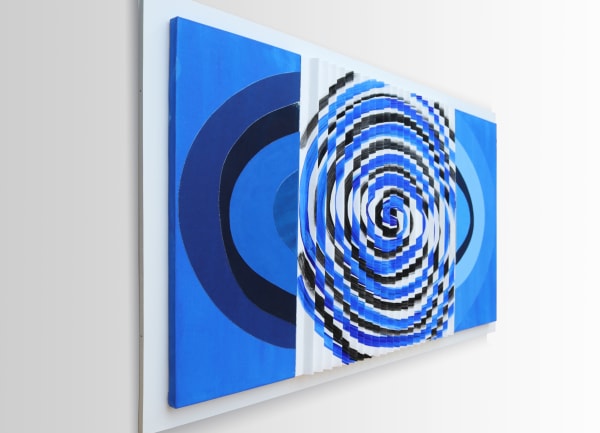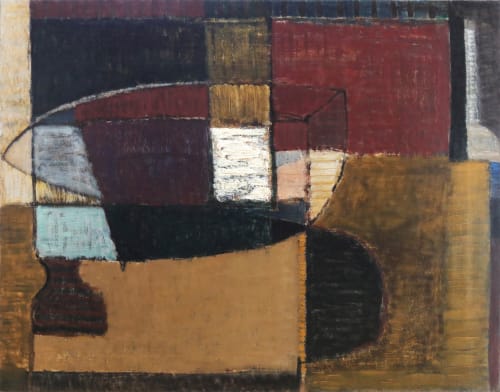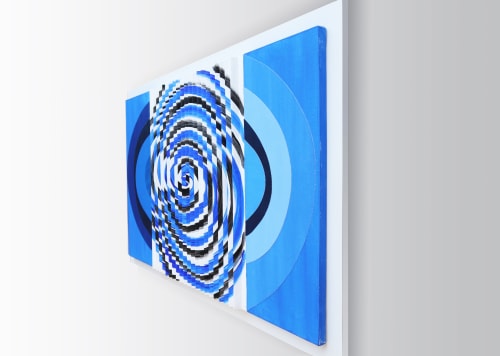Terry Frost 1915-2003
-
 Terry FrostBoat, 1950Oil on canvas71.4 x 91.5cm (28 1/8 x 36ins.)
Terry FrostBoat, 1950Oil on canvas71.4 x 91.5cm (28 1/8 x 36ins.)
Framed: 93.4 x 113.5cm ( 37 1/8 x 44 11/16ins.)View full details -
 Terry FrostRed and Black Verticals, 1959Oil on canvas127 x 76.2 cm (50 x 30 ins)
Terry FrostRed and Black Verticals, 1959Oil on canvas127 x 76.2 cm (50 x 30 ins)
Framed: 134 x 84 cm (52.8 x 33 ins)View full details -
 Terry FrostOrange and Ochre, 1959Oil on canvas63.5 x 76 cm (25 by 30 ins.)
Terry FrostOrange and Ochre, 1959Oil on canvas63.5 x 76 cm (25 by 30 ins.)
Framed: 67.9 x 80.6 cm (26.7 by 31.7 ins.)View full details -
 Terry FrostOval Blue Squeeze, 2003Acrylic and collage on canvas76 cm x 137 cm (30 ins x 54 ins)
Terry FrostOval Blue Squeeze, 2003Acrylic and collage on canvas76 cm x 137 cm (30 ins x 54 ins)
Framed 87.8 x 148 cm (34 1/2 x 58 1/4 ins)View full details -
 Terry FrostMovement, study, 1951Watercolour, bodycolour and charcoal22.8 x 20.3 cm (9 x 8 ins)
Terry FrostMovement, study, 1951Watercolour, bodycolour and charcoal22.8 x 20.3 cm (9 x 8 ins)
Framed: 44.8 x 41.7 cm (17.6 x 16.4 ins)View full details
"I didn’t come back and just paint the picture. I never was able to do that. I always have to absorb the moments and then let them go, for I have to make the idea, the discovery. Sometimes I go for a couple of years before I can get clean as it were and discover the moment in paint." Terry Frost
Terry Frost was remarkably transparent about his way of working and about what he was attempting to express in his work. So many of his contemporaries never indulged explanation preferring the mystique of inscrutability or simply pointing out that the painting is in itself the communication. Terry Frost paintings are honestly explored in his writings and interviews about his working methods and ideas thus providing a unique verbal insight into one of Britain’s leading abstract painters.
He was born in Leamington Spa in 1915. He showed an early aptitude for drawing following his uncle Fred’s lead, sketching from Boys' Own Magazine and photos. He was art editor of the school magazine at 11. At 14 he left school; his first job was in Curry’s Cycle shop where amongst other things he dressed the windows later recalling his use of tubes of crepe paper ‘to make all kinds of shapes, crinkling them up …’
Aged 17, Frost joined the Territorial Army and got a job in an aircraft factory making tea for the painters who painted the red, white and blue targets on the Wellington bomber wings; aircraft being quietly built as the nation was told there would be no war. In 1939, as part of the Territorials, Frost was called up. After serving in France and Palestine he was transferred to the Commandos. He was captured in Crete in 1941 and ultimately imprisoned in Stalag 383 in Bavaria.
There Frost found he could capture the likeness of his fellow prisoners on the back of black-out paper discarded by the German guards. In this way he met Adrian Heath ‘the first person to talk to me seriously about art’. Frost used oil from Red Cross sardine tins, a little paint from a sympathetic guard and brushes made from horse hair. For canvas he employed hessian pillows and for size, barley from the camp’s soup. In all, he painted over 200 portraits at Stalag 383. A number were sent through the Red Cross to an exhibition, 'Prisoner of War Art and Craft', organised by the Daily Telegraph at St James's Palace in 1944.
At the end of the war, Frost was intent upon becoming an artist, confounding the more conventional expectations of his family in the war torn Midlands. Back in Leamington, Frost worked in Birmingham and attended Birmingham Art School at night. Frost had seen a lot during the war; by his own account he’d seen many of his friends killed and had promised himself that he’d paint and express his new-found freedom.
In 1946, after considerable perseverance and encouragement from Adrian Heath, Frost got an ex-serviceman’s grant and with Heath's help won a place at the Camberwell School of Art in London. Adrian Heath, who was one of Stanhope Forbes' last students in Newlyn, encouraged Frost to go to Newlyn or St Ives. He plumped for St Ives where he got lodgings near Ben Nicholson and Barbara Hepworth’s home, Chy-an-Kerris in Carbis Bay and not far from a bungalow occupied by Naum and Miriam Gabo. Whilst working in a hotel, he started at Leonard Fullers' art school meeting John Anthony Park and Sven Berlin who he noted as his first modern artist friend. "I met the people who had a show in the Crypt. Peter Lanyon, Sven, Johnny Wells, Willie Barns-Graham. Lanyon was very good. He used to take me out into the landscape; we used to go drawing together. He and Sven were great supporters. They encouraged me. But you must remember these were the young ones then". Between 1946 and 49 Frost used Leonard Fuller's school effectively as his studio.
In the summer of 1947 Peter Lanyon introduced Frost to Ben Nicholson, whom he stayed in touch with whilst at Camberwell. Lanyon took Frost around West Penwith teaching him to experience the landscape. With Lanyon he went to Mullion. "When I did my blue and black painting I was walking along the quay to look at the rocks. … I would set out my geometrical divisions and then find a way to express something like Mullion Cove by putting colour references to what I’d seen and what had moved me, blue black where the rocks were wet, and the little bay at the bottom, and so I would build up and build up until I rediscovered my experience".
After 2 years in St Ives, in 1947 Frost went to Camberwell Art School to study under Victor Passmore. After seeing Frost's work Passmore told him not to come anymore – ‘go around the National Gallery, go around the modern galleries.’ Passmore wanted Frost to cut out life drawing and experience the old masters without inhibition or preconception. Frost complied but continued his attendance at the figure drawing classes whilst staying in touch with Lanyon and Nicholson. Frost would visit Adrian Heath in his home in Fitzroy Street as he was writing his book on abstract art. "I got absolutely sold on Russian Constructivism which was just about the start of abstract painting as far as I was concerned. We had the Mondrian book, the Kandinsky book, all these things were around us. So I got involved in abstraction. The more I went to galleries, the more I looked at it, the more interested I became". In 1949 Frost executed his first wholly abstract work, 'Madrigal' (Leamington Spa Art Gallery and Museum) in response to a assignment set at Camberwell. It's notable that Madrigal is constructed wholly from squares, rectangles and rhombi. The artist is yet to discover the curves and semi-circular forms that were to become so integral to his body of work.
While at Camberwell Frost hitchhiked back to St Ives and his family as often as possible. In 1948 the Arts Council bought a block of 13 Porthmeor studios. In 1950 Frost got his first studio with Ben Nicholson’s help, No4. Nicholson had No5. That year Frost painted 'Boat', where he introduced the curved forms of boat sections and the arcs of mooring lines, processing his experience of St Ives harbour. He soon built upon these themes and some of the structures that were to fill his lifetime's work with 'Walk along the Quay'. Early each morning the artist would take his young son Adrian for a walk along St Ives harbour, still a working port. Of the latter painting Frost said, "‘Walk along the Quay’ was a kind of revelation to me. (It) came from a true walk, a regular morning stroll and the constant movement always (without deep art thought, always the killer of inspiration and imagination) intrigued me. The size of the canvas … had to conform to my idea, the walk, so it was long, like the quay and narrow. Everything was happening below me so I think for the first time I managed to paint up the canvas or along the canvas, like I walked along the quay, in fact I just walked up the canvas with paint".
In January 1951 'Boat' was dispatched by the British Council to the American Abstract Artists 15th Annual Exhibition, British Section; the first time that British artists had been represented in the annual New York exhibition which celebrated the American titans of modernism. Later that year Ben Nicholson arranged for 'Walk along the Quay' to be shown into the 1951 Artists International Associations Abstract Art show in connection with Festival of Britain, alongside his own work and those of Barbara Hepworth, Adrian Heath, Victor Pasmore, Wilhelmina Barnes-Graham and Roger Hilton. Terry's works in New York and London both sold.
In 1951 Frost became curator of the Penwith Society, a new group formed by members of the St Ives Society which would be inclusive of all arts and crafts. He also became Hepworth’s part time secretary cataloguing her early work. He progressed to roughing out for Barbara Hepworth alongside Denis Mitchell, working on 10 ton pieces of Connemara limestone under Hepworth’s direction. In 1951/52 Frost exhibited at the Riverside Museum in New York, Gimpel Fils in London, and Seventeen Collectors at the Tate, the Galerie de France in Paris and the New Burlington Galleries in London. Frost had his first one-man show at the Leicester Galleries in London in 1952.
As David Lewis writes in ‘Terry Frost’, Scolar Press, "most of Terry Frost's paintings in these exhibitions derived from a theme of boats and ropes – semicircular or new moon shapes rocking back and forth down the canvas with rhythms orchestrated by diagonal or slanting lines and spirals…. Some of the paintings were black, white and grey; others were in bright sometimes primary colours".
In 1954 Frost gained a Gregory Fellowship at Leeds University and so began an intense 3 years pivotal to Frost's development as an abstract artist. A lively artistic environment with its cross fertilisation of ideas combined with the bare landscape and almost vertical fields of the Yorkshire Dales "the true experience of the black and white in Yorkshire", were embraced with enthusiasm by the young artist and spawned many of his most strident and evocative works including 'Leeds Painting' (1954), 'Orange and Black Leeds' (1957), 'Red, Black and White' (1956 and a second work, 1957, Sotheby’s June 2019). The latter was inspired by a snowbound walk with Herbert Read; "it was a clear bright day and I looked up and saw the white sun spinning on the top of a copse. Afterwards and now I recall that I thought I saw a Naples yellow blinding circle spinning on top of black verticals. I do remember that my heart almost stopped at the experience and it was gone. So I came back and painted 'Red, Black and White' 1956. I didn’t come back and just paint the picture. I never was able to do that. I never wished to do that. I always have to absorb the moments and then let them go, for I have to make the idea, the discovery. Sometimes I go for a couple of years before I can get clean as it were and discover the moment in paint".
In 1957, Terry Frost returned full-time to 4 Porthmeor Studios in St Ives. In 1958 he had his third one-man exhibition at the Leicester Galleries and a second showing at Carnegie International.
In 1960 he had his first one-man show in New York at the famous Bertha Schaefer Gallery. This was a seminal moment in Terry Frost's career. The exhibition came about as a result of a trip to Cornwall by Bertha Schaefer, following in the footsteps of Mark Rothko. On seeing Frost's work she offered him a New York solo exhibition. Frost later said of the experience: "In New York they all came to my exhibition, de Kooning, Rothko, Klein. Newman and Motherwell took me to their studios. I accepted it all as normal and they accepted me. They were all painters struggling to get somewhere like I was. They worked hard; they would sleep until noon, do eight or nine hours in the studio, and then starting at eleven at night proceeded to drink me under the table! Then we'd go at four in the morning and have breakfast at a Chinese restaurant". Frost spent 3 weeks in New York as a guest of Larry Rivers, 'The Godfather of Pop Art'. Along with the American titans of Abstract painting Frost met the Beat Poets including Alan Ginsberg. Frost was embraced by his American peers and art collectors alike with his debut New York solo exhibition proving a critical and commercial success. Works sold at the landmark Bertha Schaefer Gallery exhibition included 'Orange and Ochre' (1959).
In 1963 the Frosts moved to Banbury, an hour from London; Terry feeling "the steam had slightly run out of me". In 1963, 1966 and 1969 Frost had a series of one-man exhibitions at the Waddington Galleries and a steady stream of shows across Europe and North America over the decade.
In 1974 Frost moved back to Cornwall. St Ives was by this time heaving with tourists and its identity as home to a thriving art community, interdependent upon the indigenous fishing community, no longer defined the town. Nicholson had moved to Switzerland, Peter Lanyon had tragically died as the result of a gliding accident in 1968 and John Wells and Denis Mitchell were in Newlyn. Bryan Wynter was not far away in St Buryan. So it was understandable that Frost sought out a fresh start in West Penwith and where better than the birthplace, almost a century earlier, of the Newlyn School, and still home to Cornwall's largest fishing fleet. Frost bought Gernick Field, a house at the top of Tredavoe Lane and overlooking the harbour. In 2001 in a radio broadcast, Frost said of his home in West Penwith "that little bit of land where I am in Cornwall, about 7 miles wide, with the sea on three sides …. I can see the sun rise and the sun set from where I am every day. I’m with the gods".
He continued to show extensively throughout the seventies including ‘British Painting 1952-77’ at the Royal Academy and 3 one-man shows in 1978 alone. The 1980s and 90s were relatively fallow decades for the artist as sensibilities changed in the UK and abstract painters lost their currency, although notably never in the US. In 2003 the St Ives Tate decided to give Terry an exhibition. He was 87 and not well. The 3-month exhibition was celebrated across the national press.
Terry Frost died in St Julia’s Hospice in Hayle on 1 September 2003. His son Anthony was with him and recalls “It was painting, painting, painting, that was all he thought about. Even when he was in hospital, he would open his eyes and turn to me, give me a wink and say’ I think we should get just one more out’”.
Bristow, Roger (2013) Terry Frost A Painters Life, Samson & Co
Gooding, Mel and Carlisle, Isabel (2000) Terry Frost: Six Decades, Royal Academy of Arts
Heath, Adrian and Archer, David and Lewis, David (2000) TERRY FROST, Lund Humphries
Kemp, Dominic (2010) Terry Frost Prints A Catalogue Raisonne, Lund Humphries
Stephens, Chris, Terry Frost (St Ives Artists series), Tate Publishing 2000







